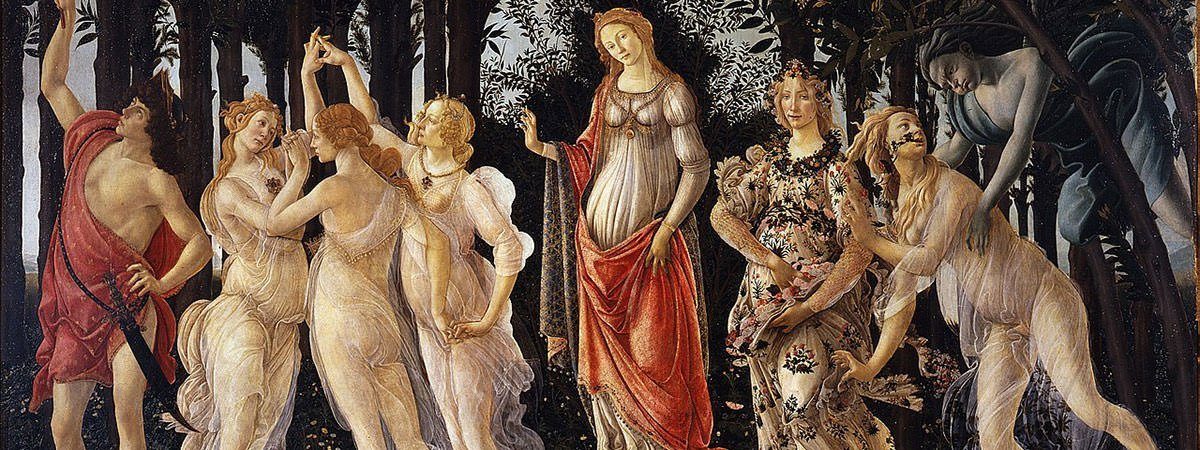Italy was the primary center of artistic development in the west during the Renaissance, a period in Europe between the Middle Ages and the modern era stretching approximately from the 14th century to the 17th century. The most famous Italian paintings of the Early Renaissance are perhaps Primavera and The Birth of Venus of Sandro Botticelli. Italian art reached its peak during the High Renaissance through the works of Leonardo da Vinci, Michelangelo and Raphael. Together these three produced some of the best known artworks in the world including the paintings Mona Lisa, The Creation of Adam and The School of Athens. The three great masters were followed by Caravaggio who was one of the most influential artists of the Baroque period in western art. His masterpiece was The Calling of St Matthew. Know more about Italian art through its 10 most famous paintings.
#10 Sistine Madonna

| Location: | Old Masters Gallery, Dresden, Germany |
| Artist: | Raphael |
| Year: | 1512 |
Raphael was one of three great masters of High Renaissance along with Michelangelo and Leonardo da Vinci. His art is known for sweetness and clarity of form, serenity, harmony, perfection and visual brilliance. His popularity during his time was primarily due to the numerous pictures he painted of Madonna and Christ Child. Sistine Madonna depicts the Madonna holding the Christ Child; and she is flanked by Saint Sixtus and Saint Barbara. Also there are two winged cherubs beneath Mary who are perhaps the most famous cherubs depicted in any picture. Such is there popularity that there are many legends regarding how Raphael painted them and they have been reproduced on everything from paper table napkins to umbrellas. Sistine Madonna is considered one of the finest paintings by many notable critics and it is especially popular in Germany where it “has been hailed as ‘supreme among the world’s paintings’ and accorded the epithet ‘divine'”.
#9 The Last Judgment
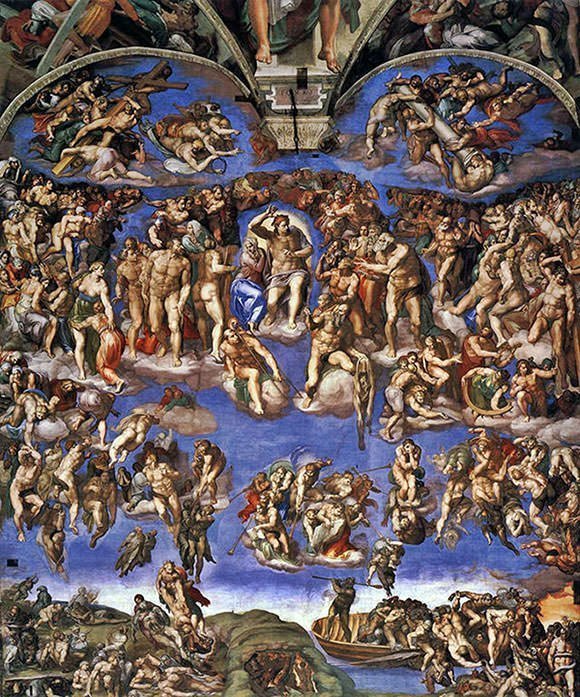
| Location: | Sistine Chapel, Vatican City |
| Artist: | Michelangelo Buonarroti |
| Year: | 1541 |
Michelangelo exerted an unparalleled influence on the development of art in the west. He is widely considered the greatest sculptor ever and, though he had low opinion of painting, he is also regarded as one of the greatest painters. The Last Judgment is one of the most influential works in fresco in the history of Western art. Painted on the altar wall of the Sistine Chapel in Vatican City, it depicts the Second Coming of Christ (a future return of Jesus to earth) and the final and eternal judgment by God of all humanity. Jesus is shown in the center of the painting and he is surrounded by prominent saints; while the Resurrection of the Dead and the Descent of the Damned into Hell is shown in the zone below. Though one of the most renowned religious paintings, The Last Judgment created much controversy. Among other things, Michelangelo was accused of mixing figures from pagan mythology into depiction of a Christian subject matter and for pursuing artistic effect over following the scriptural description of the event.
#8 The Calling of St Matthew
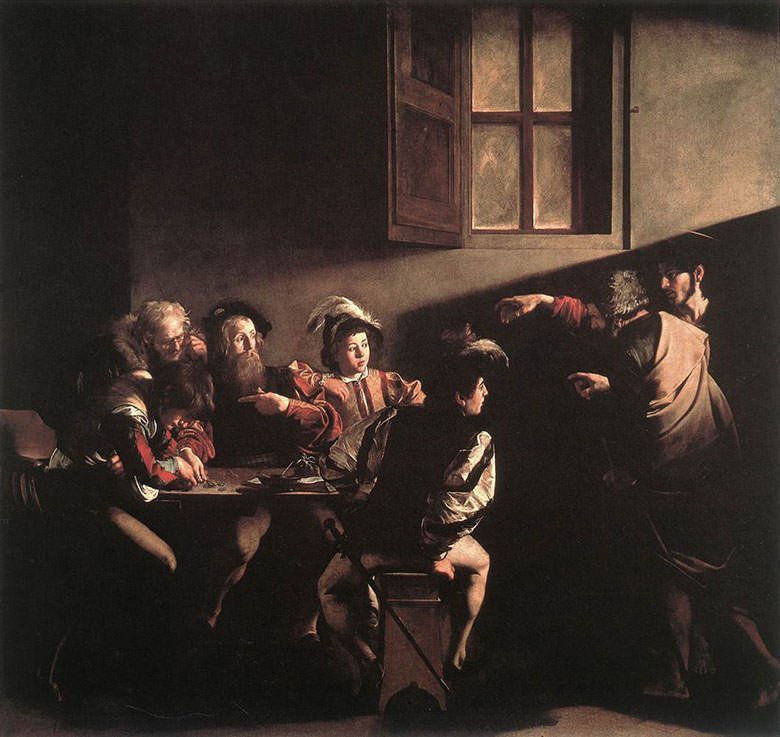
| Location: | San Luigi dei Francesi, Rome |
| Artist: | Caravaggio |
| Year: | 1600 |
Saint Matthew was one of the twelve apostles of Jesus and, according to Christian tradition, one of the four Evangelists. Matthew was initially a tax collector and Jesus Christ found him sitting at the tax collector’s booth. “Follow me”, Jesus told him, and Matthew got up and followed him. This painting depicts the moment at which Jesus inspires Matthew to follow him. Caravaggio is one of the most influential artists in European art history. Among other things; he painted from life, without drawings; and developed a technique called tenebrism, which was marked by the use of violent contrasts of light and dark. This helped him to create paintings with high drama and emotional intensity. The Calling of St Matthew was an immediate sensation when it was first displayed and it is perhaps the most famous work by the artist.
#7 Venus of Urbino
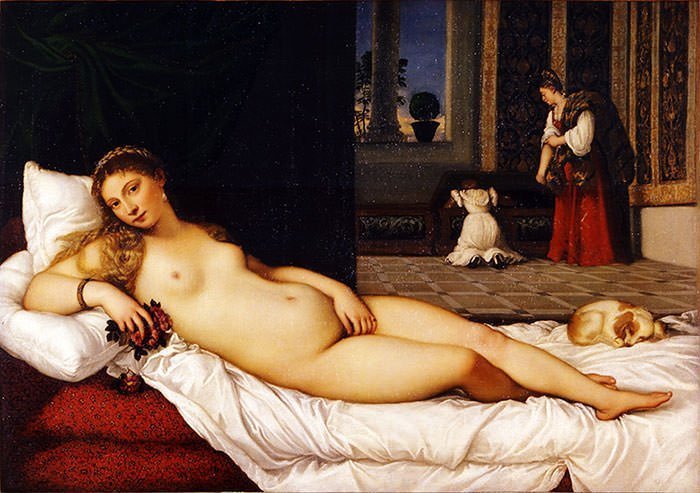
| Location: | Uffizi Gallery, Florence, Italy |
| Artist: | Titian |
| Year: | 1538 |
Titian was one of the greatest and most versatile of Italian painters. This painting was commissioned to him by Guidobaldo Rovere, the Duke of Urbino. It shows the goddess Venus, reclining on a couch or bed in the surroundings of a Renaissance palace. The painting is unapologetically erotic with Venus staring straight at the viewer, unconcerned with her nudity. In 1510, Titian completed one of Giorgione’s most famous works, Sleeping Venus. Venus of Urbino is based on Giorgione’s masterpiece and the two paintings are considered among the finest ever in terms of sheer beauty of form. They went on to be hugely influential and established the standard for the reclining nude female obliquely placed in the picture space. Venus of Urbino inspired several future works including the Édouard Manet’s masterpiece Olympia.
#6 Primavera
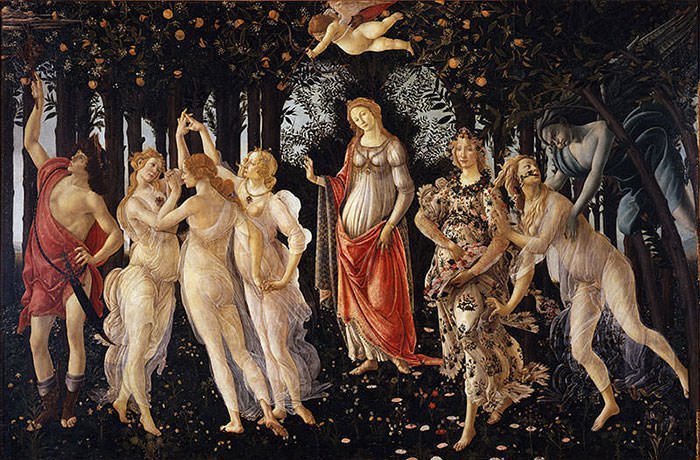
| Location: | Uffizi Gallery, Florence, Italy |
| Artist: | Sandro Botticelli |
| Year: | 1482 |
Sandro Botticelli was one of the leading painters of the Early Renaissance. This painting is his most famous work after The Birth of Venus. It has been described as “one of the most written about and most controversial paintings in the world” as well as “one of the most popular paintings in Western art”. It was first called Primavera by art historian Giorgio Vasari in 1550. There are numerous interpretations of the painting. It is generally believed that it is “an elaborate mythological allegory of the burgeoning fertility of the world.” Though the exact meaning of the painting is debated, identities of the figures in the painting is known. In the center is the Roman goddess, Venus; to the far left is Mercury, the god of the month of May; and to his right is a group called the Three Graces. On the far right is Zephyrus, the west wind, about to take a nymph named Chloris who transforms to Flora, the goddess of flowers.
#5 The School of Athens
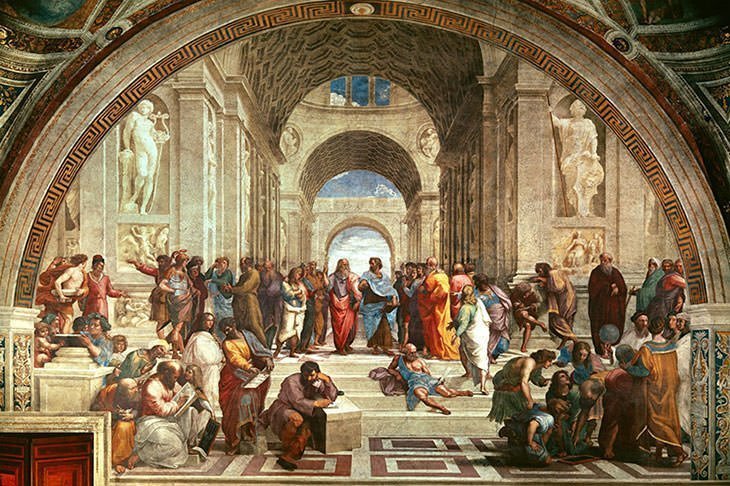
| Location: | Apostolic Palace, Vatican City |
| Artist: | Raphael |
| Year: | 1511 |
Raphael’s masterpiece, The School of Athens, is one of the four main frescoes on the walls of the Stanze di Raffaello, in the Apostolic Palace in the Vatican. The four paintings epitomize Philosophy, Poetry, Theology and Law; with The School of Athens representing Philosophy. In the center of the fresco, at its central point, are the two undisputed main subjects: Plato on the left and Aristotle, his student, on the right. Both figures hold bound copies of their books in their left hands while gesturing with their right. Critics have suggested that every great Greek philosopher can be found among the 21 painted in the painting. However, apart from Plato and Aristotle, no one’s identity can be verified with certainty. The School of Athens is considered “the perfect embodiment of the classical spirit of the High Renaissance” and it is the most famous painting by Raphael.
#4 The Last Supper
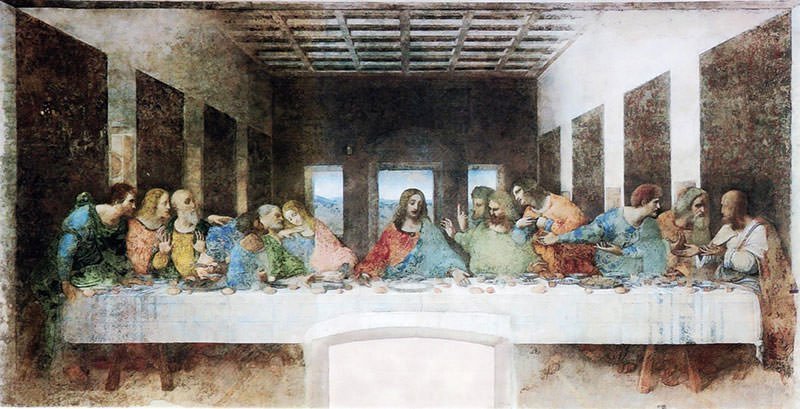
| Location: | Santa Maria delle Grazie, Milan, Italy |
| Artist: | Leonardo da Vinci |
| Year: | 1498 |
Leonardo da Vinci is now renowned as the prime example of the “Universal Genius” due to his accomplishments in a wide variety of fields. However for four centuries after his death, his fame rested primarily on his laurels as a painter. His most famous artistic achievement after the Mona Lisa, this painting represents the scene of The Last Supper of Jesus with his disciples. In it, Leonardo masterfully depicts the bewilderment and confusion that occurs among the disciples of Jesus when he announces that one of them would betray him. Leonardo’s detailed knowledge of anatomy, light, botany and geology; his interest in how humans register emotion in expression and gesture; and his subtle gradation of tone; all come together to make this painting among the most revered and famous religious paintings of all time. Some people believe that the person to the right of Jesus in the painting is not John the Apostle, but a woman named Mary Magdalene. This belief plays a central role in Dan Brown’s fiction novel The Da Vinci Code.
#3 The Birth of Venus
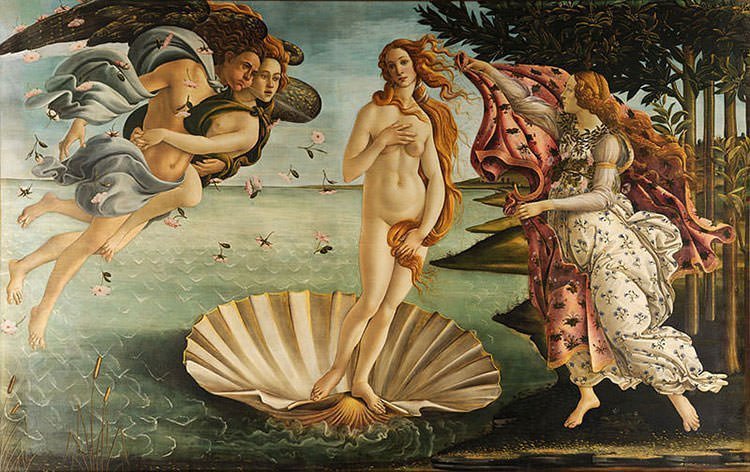
| Location: | Uffizi Gallery, Florence, Italy |
| Artist: | Sandro Botticelli |
| Year: | 1486 |
Botticelli’s Primavera and The Birth of Venus are among the most famous paintings in the world, and icons of the Italian Renaissance. As depictions of subjects from classical mythology on a very large scale they were virtually unprecedented in Western art since classical antiquity. Of the two, the Birth of Venus is even more popular. At its center is the newly born Venus, the Greek goddess whose functions encompass love, beauty, desire, sex and fertility. She is arriving at the shore after her birth having emerged from the sea fully-grown. She stands nude in a giant scallop shell. At the left the wind god Zephyr blows at her. At the right Hora of Spring, a minor Greek goddess, holds out a rich cloak to cover her naked body. Unlike Primavera, the Birth of Venus depicts a traditional scene from Greek mythology and it is thus not as difficult to decipher. Its enormous popularity lies in its visual appeal.
#2 The Creation of Adam
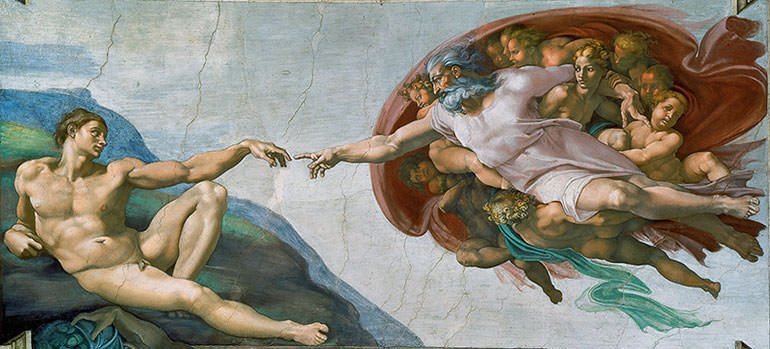
| Location: | Sistine Chapel, Vatican City |
| Artist: | Michelangelo Buonarroti |
| Year: | 1512 |
The work done by Michelangelo on the Sistine Chapel ceiling is a cornerstone of Renaissance art and The Creation of Adam is the most famous fresco panel of the masterpiece. The painting illustrates the Biblical creation narrative from the Book of Genesis in which God breathes life into Adam, the first man. God is depicted as an elderly white-bearded man wrapped in a swirling cloak while Adam, on the lower left, is completely nude. There has been much analysis of the painting and, among other things, it has been found that the shapes portrayed behind the figure of God are an anatomically accurate picture of the human brain; the red cloth around God has the shape of a human uterus; and the green scarf is thought to be a newly cut umbilical cord. The Creation of Adam is perhaps the best known painting after Mona Lisa; and along with The Last Supper, it is the most replicated religious painting of all time. The image of the near-touching hands of God and Adam has become iconic of humanity and has been imitated and parodied innumerable times.
#1 Mona Lisa
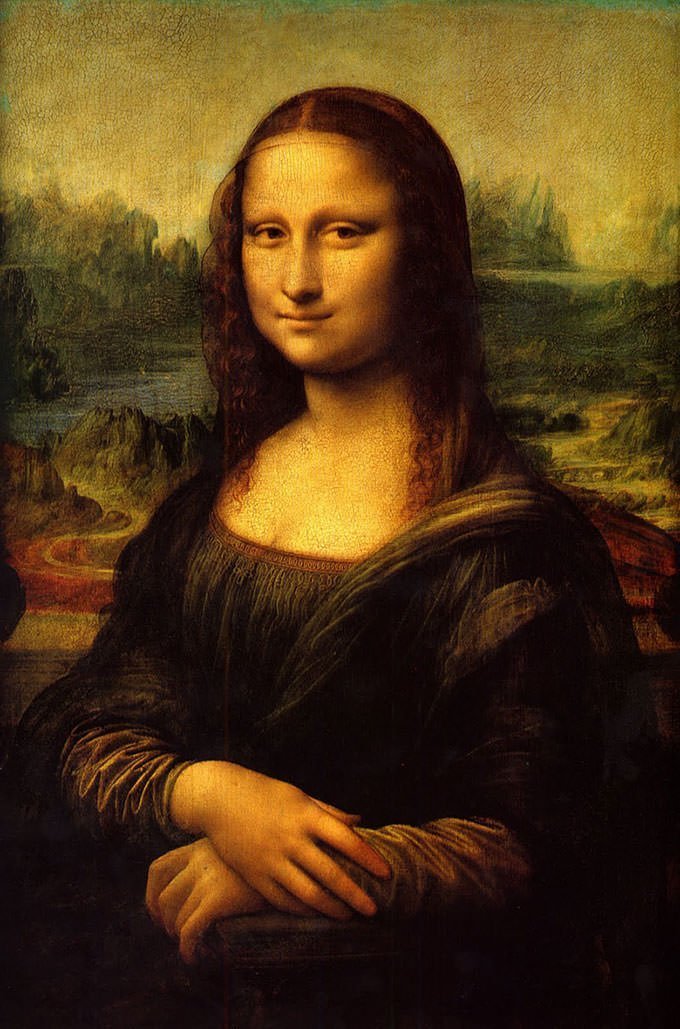
| Location: | Louvre Museum, Paris |
| Artist: | Leonardo da Vinci |
| Year: | 1517 |
Leonardo da Vinci is regarded as the preeminent figure of the Italian Renaissance. His masterpiece, the Mona Lisa has been acclaimed as “the best known, the most visited, the most written about, the most sung about and the most parodied work of art in the world”. Its fame rests, in particular, on the elusive smile on the woman’s face which is why it is also known as “la Gioconda”, or the laughing one. Based on accounts from an early biographer, the painting is a picture of Lisa Gherardini, the real-life wife of a merchant. For Da Vinci, Mona Lisa was forever a work in progress, as it was his attempt at perfection. The painting was never delivered to its commissioner; he kept it with him till the end of his life. Guinness World Records lists the Mona Lisa as having the highest insurance value for a painting in history. It was assessed at US$100 million on December 14, 1962, which after adjusting inflation, would be around US$790 million in 2016.

